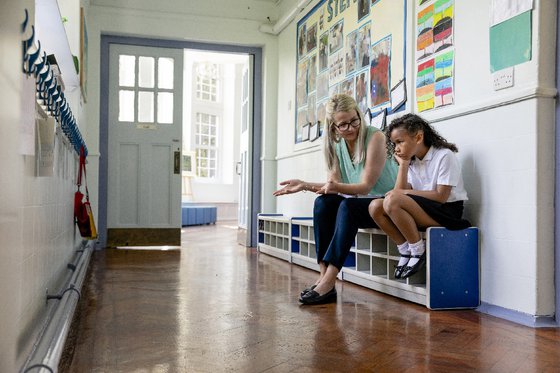A publication of the Association of California School Administrators
Behavior interventions
Strategies for cultivating positive behaviors in students
Strategies for cultivating positive behaviors in students
Behavior interventions
Strategies for cultivating positive behaviors in students
Strategies for cultivating positive behaviors in students
January | February 2024

Mindful discipline: Promoting the social-emotional well-being
of students
By Greg Gero
When students make decisions that cause harm to themselves and others, it can be challenging to maintain a focus on the long-term goals we have for them — growing into healthy adults with the ability to manage their emotions, empathize with others and live with integrity. Mindful discipline is a three-step process that can address the short-term incident while also addressing the long-term growth of the child.
Unveiling the ‘magic potion’ for an engaged classroom
By Carmen Beck and Sangeetha Carmona
If student behavior is just a reaction, how can we learn to respond in a way that is beneficial for all? The “magic potion” is a combination of asset-based pedagogy and the ABCs of behavior. This approach empowers students to actively engage in their learning, develop positive connections and achieve their full potential, fostering a sense of belonging, motivation and well-being as a classroom community.
MTSS from the youngest up
By Pam Cheng, Heather Elston and Rosanna Palomo
In November 2022, K-12 school leaders everywhere were witnessing the wide range of development in their youngest learners as a reflection of their varying experiences through a historic pandemic. An honest discussion of site principals led to a realization: The school system needs to be ready for every TK and kindergarten student, however they arrive.
The greatest barrier to school improvement you are probably missing: trauma
By Matthew Fleming
Are you seeing bigger challenges to academic achievement and behavior than in prior years? You are not alone. But this time, another program or curriculum is not the answer. It’s going to require doing something much more painful than adding another initiative. We need to cut as many initiatives as we can to allow educators time and space to address the real issue: trauma.
Harnessing the power of a positive ratio of interactions
By Cristy Coughlin, Jessica Sprick and Jeremy Resnick
Adults can use the concept of ratios of interactions (ROIs) as a first, and oftentimes best, strategy to support students in making meaningful behavioral change. Achieving a high ratio of positive interactions means making the conscious effort to interact with every student more frequently when the student is behaving appropriately than when they are behaving inappropriately.
Helping students RISE after suspension
By David McPhee and Sheri K. Stevens-Parker
One district started doing a simple thing: Visiting suspended students before they return to school. During these RISE visits, restorative practitioners and teachers on special assignment help families and students explore the underlying barriers to positive behavior and identify interventions that put students on a path to achieving their best.
Implementing a Multi-Tiered System of Support
By H. Scott Pickle and Marilyn Shepherd
The Multi-Tiered System of Support framework is a powerful system, rooted in research findings, and offers innovative solutions to the many ongoing challenges in schools of providing proper academic, behavioral and social-emotional support. One school’s BEAR Center was designed to break the cycle of trauma occurring in the classroom and provide a place for a timeout.
ADVERTISEMENT



